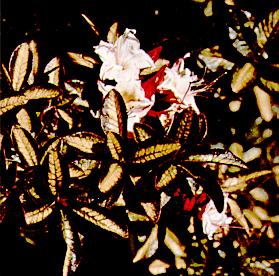QBARS - v30n3 Western Sports and Events
Western Sports and Events
Frank D. Mossman, M.D., Vancouver, Washington
Sports are seen in evergreen azaleas, other rhododendrons, and many other genera, too. The flower color, leaf type or some other character are different from the remainder of the plant. The sporting potential may remain unseen externally until some release mechanism exposes the hidden trait. Some interesting and occasionally important plants have appeared originally as sports.
When an unusual flower or leaf appears on a domestic plant, it may be obvious. In the field where a brush tangle of numerous plants obscures the origin of a particular cane, the differentiation of clones from sports is more difficult. Are there two separate bushes in a tangle of brush or one bush with a sport?
In 1967, Britt Smith of Kent, Washington and I found our first, picotee flowers on R. occidentale . On May 30, while looking into a roadside bramble patch mixed with our favorite shrub, white flowers with a lavender red margin around each petal were discovered (SM 113). Other red margin flowers have subsequently been found within the area, about five miles long near Patrick's Point in the northern California coastal fog belt: SM 120, 229, 231, 245, 303, 307, 502, 803 and some that did not receive a number. Britt Smith found SM 502 in 1971, reported in the A.R.S. Bulletin with pictures (October '71 Vol.25 #4). This remarkable find has become a shrine visited by many flower lovers. The entrance pathway is nearly impassable now because of the encroaching spruce, bramble, salal, and azalea. The round trip from the road now needs about thirty minutes. I have even performed this little feat at night, being careful to take two flashlights on a hurried seed collection trip.
We are now certain that SM 502 is a mixture of two or three clones or sports. SM 502 'light' has large pale green leaves and white medium size flowers with red margins. Rooted cuttings grow vigorously. SM 502 'dark' has small, recurved, plum-colored leaves and small red flowers. Rooted cuttings are very slow. This clone is apparently a true dwarf, likely a sport of the 'light' form for reasons that have become apparent through many years of observation, and will be set forth here.
A large piece of SM 231 was planted several years ago at my office in Vancouver, Washington. The small white flowers with lavender red margins make a fine show every May. In 1974 a single, strong-growing cane in the middle of this plant was observed to have much smaller leaves than the rest of the plant, and the leaves were deep plum color in contrast to the larger ordinary green leaves on the remainder of the plant. In 1975 small red flowers appeared on this cane, very similar to the flowers of SM 502 'dark'. In the wild these two clones, SM 502 and 231 are about one half mile apart. Britt Smith observed this SM 231 sport and reports a similar phenomenon on another portion of the original bush now growing at his place in Kent, Washington.
Another picotee flowered bush of R. occidentale growing on a hillside two miles from SM231 in the California native situation, is but sixteen inches high. During the seven years we have studied this clone, SM 307, no significant increase in height has occurred. Rooted cuttings remain small for years, also. The leaves are miniature, recurved, and deeply pigmented, similar to those of SM 502 'dark' and SM 231 'sport'. The flowers are white with lavender red margins. In late May 1975, Mr. H. H. Davidian, Britt and Jean Smith, Bob and Marge Badger and my wife, Doris and I visited this plant in bloom. This was a truly momentous occasion for many reasons, the most notable of which was Mr. Davidian's observation on an immediately adjacent azalea, a truss with flowers some of which were similar to SM 307 and some of which were the very ordinary non-picotee flowers on the remainder of this taller-growing bush! When Britt first found SM 307, in 1969, we carefully cut back surrounding competitors according to the flowers and leaves thereon. Some of these canes have re-grown differently, now with the same fine caliber, twiggy wood, and dwarf habit of SM 307 and the same leaves and flowers of SM307. The pruning released the sporting activity!
About one quarter mile south of SM 307 is SM 803 another picotee azalea, growing atop Stagecoach Hill. Again the flowers are white with lavender red margins and of medium size. The bush is about two feet high. The leaves are normal size and pale green. Two canes on one side of the shrub have much smaller, very deeply-pigmented, plum-colored, recurved leaves and the small flowers are red, another sport.
This collection of picotee azaleas illustrates that, R. occidentale , like many other plants, is capable of sporting. What we originally thought were sister seedlings are often sports of adjacent shrubs. These sports are usually not vigorous growers for us. Cuttings root with difficulty and require special care later. They bloom sparsely in the field and also in domestic gardens. These sports seem obvious now when all the facts above are considered. We will be on the look out for less obvious sports. Numerous crosses have been made and we are attempting to produce a picotee type Knaphill azalea. SM 307 x SM 502 'dark' produced many vigorous plants, but a few were true dwarfs with much red pigment in buds, new wood, and leaves. Most of these dwarfs have died. One concludes the concentration of pigment in these sports can be reproduced sexually but not with the certainty of vegetative techniques.

|
|
R. occidentale
SM 906
Photo by Frank Mossman |
